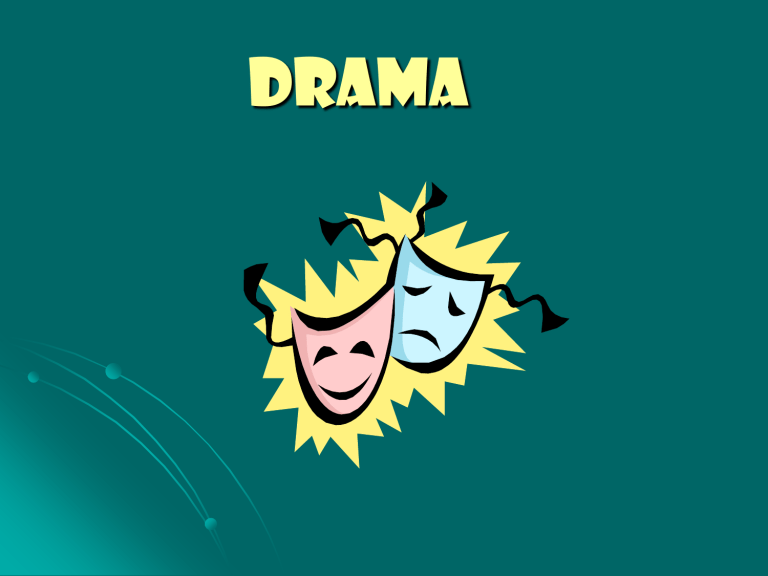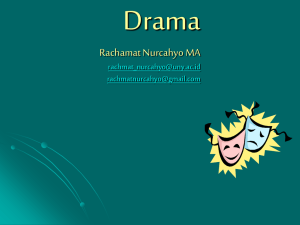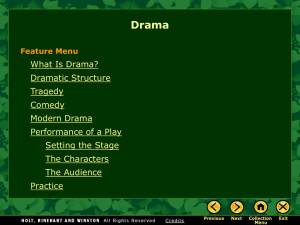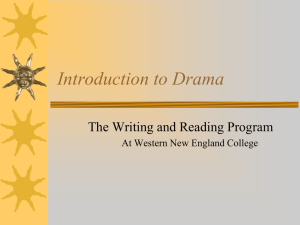Introduction to Drama: Types, Structure, and Performance
advertisement

DRAMA EU: Literature serves as a means of preserving unchanging values. EQ: How does literature help preserve the world’s unchanging values? What Is Drama? A drama is a story enacted onstage for a live audience. What Is Drama? Origins of Drama The word drama comes from the Greek verb dran, which means “to do.” The earliest known plays . . . were written around the fifth century B.C. produced for festivals to honor Dionysus, the god of wine and fertility Ten-Minute Plays . Ten-minute plays have become very popular in recent years with the advent of The Actors Theatre of Louisville contest A good ten-minute play is not a sketch or an extended gag, but rather a complete, compact play, with a beginning, middle and end Ten-Minute Plays . It typically takes place in one scene and runs no more than ten pages . In fact, because many contests disqualify entries with more than ten pages, it's a good idea to adhere to that page limit religiously. One-Act Plays One-acts can run anywhere from fifteen minutes to an hour or more. While technically, the one-act gets its name from having only one act (however long that might be), it's more commonly thought of as a play that isn't long enough to constitute a full evening. Arguably the most popular length for oneacts is around a half-hour. At this length, a play can fit on a bill with a pair of other one-acts, and if your play is suitable for high school production, thirty minutes is a good length for a competition play. A good one-act focuses on one main action or problem; there's not time to get into complicated layers of plot. And for practical reasons, it's a good idea to keep your play to one set and as few scenes as possible. Why? Let's say that your one-act is on a bill with two other one-acts, a common scenario. Let's further say that your one-act has two distinct settings, requiring two different sets and a set change in the middle of an already short play Not a good thing. Each of the other one-acts already has its own set requirements, so suddenly the theater is faced with building four different sets for one evening. Not likely to happen. Full-Length Plays Full-length plays are also called evening-length plays, because they're long enough to be their own evening. How long is that? Anywhere from around seventy or eighty minutes and up. How up is up? These days, with TV shrinking our attention spans, you'd better have a very good reason to keep an audience in the theater for much longer than two hours. And it's always a good idea to write your play so that it can be produced, if necessary, with minimal set and technical requirements. This doesn't mean that an ambitious designer can't go to town on your script if that possibility exists, but if producing your play requires eight set changes or filling the stage with water, most theaters will not be able to afford you. Musicals Musicals can run the gamut (extent) in length from ten minutes (though these are rare, because it's not very cost effective to assemble a band to play for only ten minutes) to three hours. Again, the middle ground somewhere between ninety minutes and two hours, is probably the one to shoot for. Dramatic Structure Like the plot of a story, the plot of a play involves characters who face a problem or conflict. Complications tension builds Exposition characters and conflict are introduced Climax point of highest tension; action determines how the conflict will be resolved Resolution conflict is resolved; play ends Dramatic Structure Conflict is a struggle or clash between opposing characters or forces. A conflict may develop . . . between characters who want different things or the same thing between a character and his or her circumstances within a character who is torn by competing desires Tragedy A tragedy is a play that ends unhappily. • Most classic Greek tragedies deal with serious, universal themes such as right and wrong justice and injustice life and death • Tragedies pit human limitations against the larger forces of destiny. Tragedy The protagonist of most classical tragedies is a tragic hero. This hero • is noble and in many ways admirable • has a tragic flaw, a personal failing that leads to a tragic end pride rebelliousness jealousy Comedy A comedy is a play that ends happily. The plot usually centers on a romantic conflict. boy meets girl boy loses girl boy wins girl Comedy The main characters in a comedy could be anyone: nobility townspeople servants Comedy • Comic complications always occur before the conflict is resolved. • In most cases, the play ends with a wedding. Modern Comedy Modern Comedies In modern comedies, the genders in this romantic plot pattern sometimes are reversed. Modern Drama A modern play • may be tragedy, comedy, or a mixture of the two • usually focuses on personal issues • usually is about ordinary people Modern Drama Modern playwrights often experiment with unconventional plot structures. long flashbacks visual projections of a character’s private thoughts music Performance of a Play When you read a play, remember that it is meant to be performed for an audience. Stage Directions Performance Playwright describes setting and characters’ actions and manner. Theater artists bring the playwright’s vision to life on the stage. [Wyona is sitting on the couch. She sees Paul and jumps to her feet.] Wyona. [Angrily.] What do you want? The audience responds to the play and shares the experience. Performance of a Play Theater artists include Actors Directors Lighting technicians Stage crew Setting the Stage Stages can have many different sizes and layouts. “Thrust” stage • The stage extends into the viewing area. • The audience surrounds the stage on three sides. Setting the Stage “In the round” stage is surrounded by an audience on all sides. Setting the Stage Proscenium stage • The playing area extends behind an opening called a “proscenium arch.” • The audience sits on one side looking into the action. upstage stage right stage left downstage Setting the Stage Stages in Shakespeare’s time were thrust stages. Setting the Stage Scene design transforms a bare stage into the world of the play. Scene design consists of • sets • lighting • costumes • props Setting the Stage A stage’s set might be realistic and detailed abstract and minimal Setting the Stage A lighting director skillfully uses light to change the mood and appearance of the set. Setting the Stage The costume director works with the director to design the actors’ costumes. • Like sets, costumes can be detailed minimal Setting the Stage Props (short for properties) are items that the characters carry or handle onstage. • The person in charge of props must make sure that the right props are available to the actors at the right moments. The Characters The characters’ speech may take any of the following forms. Dialogue: conversations of characters onstage Monologue: long speech given by one character to others Soliloquy: speech by a character alone onstage to himself or herself or to the audience Asides: remarks made to the audience or to one character; the other characters onstage do not hear an aside The Audience Finally, a play needs an audience to experience the performance understand the story respond to the characters The End This powerpoint was kindly donated to www.worldofteaching.com http://www.worldofteaching.com is home to over a thousand powerpoints submitted by teachers. This is a completely free site and requires no registration. Please visit and I hope it will help in your teaching.





